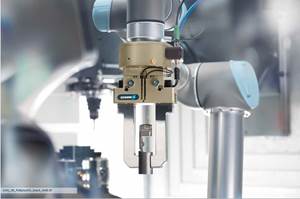Clamping Difficult Workpieces With Ice
What does a shop do with a workpiece that needs machining but can't be toe-clamped, bolted, chucked or held in a conventional vise? Securely holding many so called exotic materials - ceramics, carbides, glass, and other brittle blanks - is a challenge. The Ice Vice may offer a solution.
Share





What does a shop do with a workpiece that needs machining but can't be toe-clamped, bolted, chucked or held in a conventional vise? Securely holding many so called exotic materials—ceramics, carbides, glass, and other brittle blanks—is a challenge. Plus, many of these workpieces are asymmetrical in shape, further exacerbating the workholding challenge.
A system for holding the unholdable is what German manufacturer Horst Witte (Bleckede, Germany) demonstrated at IMTS in cooperation with its U.S. representative, Ibag North America (North Haven, Connecticut). Called the Ice Vise, this system uses the adhesive power of frozen water to securely hold workpieces that could be damaged using conventional methods or require very specialized fixturing because of their shapes.
Most who live in places where winters are cold know the adhesive power of frozen water. Seeing the rubber blade of a windshield wiper tear off its holder and remain affixed to the windshield on a cold morning is proof of ice's powerful grip.
The ice vise system has two main components: an external cooling unit and the freeze plate. An umbilical connects the freeze unit to the machine tool mounted plate. The freeze plate is designed to attach to the machine tool worktable like a subtable would.
In operation, a workpiece is placed on the previously cooled freeze plate. A thin film of water is sprayed onto the plate surface with the workpiece in place. The freeze plate is then activated, lowering the temperature of the water and its captive workpiece to -10º C and securing the work for processing.
Approximately 90 seconds later the workpiece is frozen solidly to the plate. The company says that -10º C seems to be the ideal temperature because the ice itself has not yet become brittle and cracked. Therefore, the maximum holding potential is realized at that temperature. The integrated electronics in the ice vise system maintain the temperature of the plate to ±2º C. Built-in sensors check the temperature constantly. To shorten clamping/unclamping cycles, which are about 90 seconds for each, a vacuum connection can be used to quickly position workpieces.
The system uses cold air, which is recirculated through the freeze plate, to quickly adhere the work to the surface. The air is fed in and compressed to a minimum of 6 bar pressure. The ice vise can be connected to any shop air supply. It is the movement of the air that cools the plate. Reversing the direction of the air results in the thawing cycle for releasing the work from the vise. The unit is designed to work with an ambient shop temperature of 20º C. Adjustments can be made for different ambient conditions.
Workholding is a challenge for any shop. Finding a cost effective method, short of specially built fixturing, to hold difficult workpieces is a goal for reducing costs. The ice vise is not a workholder for all parts, but it does possess the potential to solve some knotty workholding problems.
Applications that might benefit from this technology include brittle, fragile and asymmetrical blanks. Another advantage of using water in the device is that materials (for example honeycomb) that are difficult to hold because they present insufficient surface area to vacuum mount, can easily be held with an ice vise. The water tends to migrate into the pores of a honeycomb structure, providing additional surface area for holding and adding reinforcement to the fragile material.
Related Content
Navigating Large-Scale CNC Machining: Suburban Tool’s Niche Strategy to Stay Competitive
Facing increasing competition from lower-cost imports, Suburban Tool made a move toward large-scale, in-house machining. By identifying a niche in large, precision angle plates and tombstones, the company has strengthened its ability to control quality and protect its reputation.
Read MoreSMW Autoblok's Workholding System Removes Obstacles
Eastec 2023: MillTec makes it is easier to carry out complex operations with five-sided access to the part.
Read MoreLean Approach to Automated Machine Tending Delivers Quicker Paths to Success
Almost any shop can automate at least some of its production, even in low-volume, high-mix applications. The key to getting started is finding the simplest solutions that fit your requirements. It helps to work with an automation partner that understands your needs.
Read MoreUsing Jaws as Grippers Enables Flexible, Low-Cost Automation
VersaBuilt’s automation systems significantly boosted Innovative Fabrication’s revenue. In return, the shop has helped VersaBuilt optimize its products.
Read MoreRead Next
Machine Shop MBA
Making Chips and 91ÊÓƵÍøÕ¾ÎÛ are teaming up for a new podcast series called Machine Shop MBA—designed to help manufacturers measure their success against the industry’s best. Through the lens of the Top Shops benchmarking program, the series explores the KPIs that set high-performing shops apart, from machine utilization and first-pass yield to employee engagement and revenue per employee.
Read MoreAMRs Are Moving Into Manufacturing: 4 Considerations for Implementation
AMRs can provide a flexible, easy-to-use automation platform so long as manufacturers choose a suitable task and prepare their facilities.
Read MoreLast Chance! 2025 Top Shops Benchmarking Survey Still Open Through April 30
Don’t miss out! 91ÊÓƵÍøÕ¾ÎÛ's Top Shops Benchmarking Survey is still open — but not for long. This is your last chance to a receive free, customized benchmarking report that includes actionable feedback across several shopfloor and business metrics.
Read More























